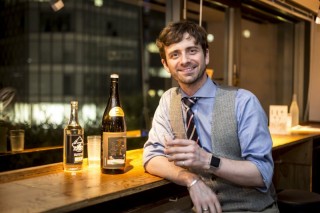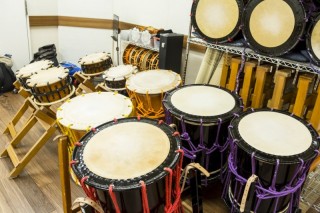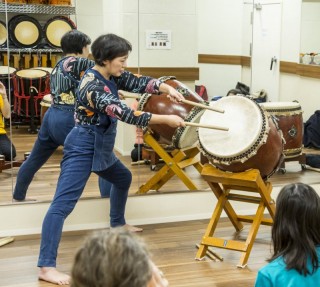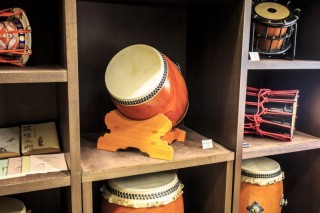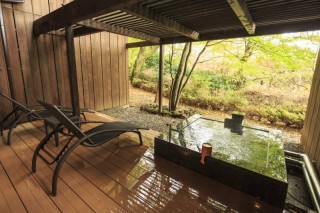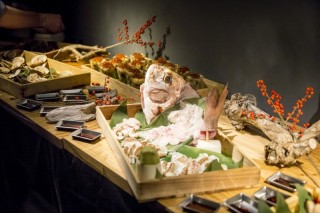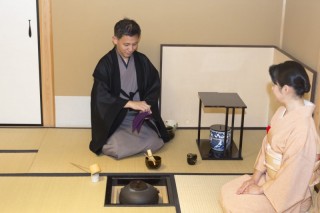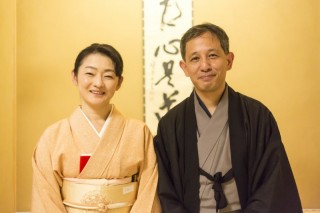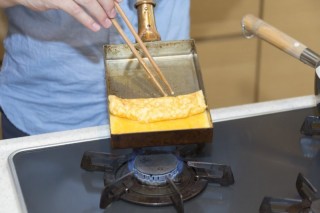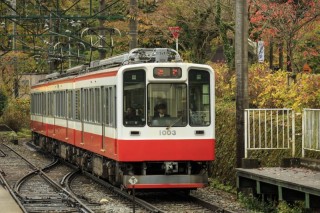Loading
Search
▼ Stay and Experience Tokyo
- Category:Experience
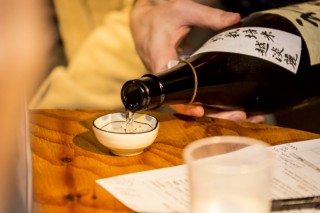
JAPAN TRAVEL
Activities and more with Airbnb
The delightful challenge travelers face when they arrive in Tokyo is choosing how to make the most of limited time. With a history spanning thousands of years, the city is full of things to explore. Airbnb aims to solve that conundrum.
The U.S.-based company known for its ultra-local lodging began offering experiences, vetted outings run by local experts, in November 2016. In Tokyo and Osaka there are nearly 400 experiences that offer an intimate glimpse of Japanese culture.
Shochu and Sake Sampling
As dusk falls and rain threatens, café lights lend the streets a soft glow as I turn off a busy thorough-fare in Omotesando, Tokyo’s Beverly Hills, to find my Airbnb lodging. The rain starts just as I open the door to my home for the night: a four-story, three-bedroom home with in-floor heating.
Ignoring the siren call of the enormous bathtub and roomy kitchen, I set out for Shinjuku to meet Christopher Pellegrini, author of The Shochu Handbook, for my first Airbnb experience: sake and shochu tasting.
Christopher, an infectious ball of enthusiasm, starts me with a sparkling sake, a sweet brew that shimmers on the tongue. “A proper tasting,” he says, “starts with the smell. Does the scent match anything you know? Then sip.”
I follow suit, sniffing and sipping, and words like ‘fruity’ and ‘pear’ come to mind. Three more sakes follow, and Pellegrini explains the numbers on the back of the bottle and how that relates to the polishing of the rice. The lower the number, the more of the original grain has been polished away, resulting in a light, balanced sake. He also describes the sake brewing process (more akin to beer than wine) and its main ingredient koji.
Christopher, an infectious ball of enthusiasm, starts me with a sparkling sake, a sweet brew that shimmers on the tongue. “A proper tasting,” he says, “starts with the smell. Does the scent match anything you know? Then sip.”
I follow suit, sniffing and sipping, and words like ‘fruity’ and ‘pear’ come to mind. Three more sakes follow, and Pellegrini explains the numbers on the back of the bottle and how that relates to the polishing of the rice. The lower the number, the more of the original grain has been polished away, resulting in a light, balanced sake. He also describes the sake brewing process (more akin to beer than wine) and its main ingredient koji.
A moldy rice, koji is also used to make miso and soy sauce. “In this case,” he says raising the emerald green bottle of sake we are currently enjoying, “brewers use it to ferment the rice to make sake.”
As we nibble on an assortment of Tsukiji-fresh fish catered in by Kazuhiro, another Airbnb Experience host, Pellegrini explains that koji is also used for shochu, a distilled liquor that can be made from barley to seaweed to tomatoes. “Fifty-three different ingredients are allowed.
The single distillation process means that more of the flavor of the ingredients gets left behind,” he says handing me a sample of bamboo shochu. Warm and earthy, I wonder what pandas would think of this take on their favorite dish. “Shochu is Japan’s big secret,” Pellegrini adds with a smile. I’ll toast to that.
Drumming in Old Tokyo
The next morning, I settle into my chair at the Royal Coffee House, a traditional Japanese kissaten (coffee house) in Asakusa. Established in 1962, the plush red velvet, gilt-framed artwork and dark wood tables typical of that era make for a relaxed atmosphere.
As we nibble on an assortment of Tsukiji-fresh fish catered in by Kazuhiro, another Airbnb Experience host, Pellegrini explains that koji is also used for shochu, a distilled liquor that can be made from barley to seaweed to tomatoes. “Fifty-three different ingredients are allowed.
The single distillation process means that more of the flavor of the ingredients gets left behind,” he says handing me a sample of bamboo shochu. Warm and earthy, I wonder what pandas would think of this take on their favorite dish. “Shochu is Japan’s big secret,” Pellegrini adds with a smile. I’ll toast to that.
Drumming in Old Tokyo
The next morning, I settle into my chair at the Royal Coffee House, a traditional Japanese kissaten (coffee house) in Asakusa. Established in 1962, the plush red velvet, gilt-framed artwork and dark wood tables typical of that era make for a relaxed atmosphere.
A handful of regulars arrive to read the newspaper and chat with the staff. Thick toast topped with ham and cheese, a generous helping of potato salad and a side of yogurt soon arrive, and I dig in. However, one item baffles me.
“Konbu-cha,” the waitress tells me, and sure enough, I catch a scent of the sea. Dried konbu (kelp) steeped in warm water is served as a nutrient-rich digestive. Popular since the Edo Period, it is just the boost I need for my next experience.
“Konbu-cha,” the waitress tells me, and sure enough, I catch a scent of the sea. Dried konbu (kelp) steeped in warm water is served as a nutrient-rich digestive. Popular since the Edo Period, it is just the boost I need for my next experience.
“Japanese people say that the sound of thunder is the gods drumming,” says Junko Suzuki pointing to the drum one of the guardians at Senso-ji, Tokyo’s oldest temple, where we meet. She guides me through dense crowds and clouds of incense to the temple itself and then shows me a small nearby shrine where her drumming group performs during festivals.
A drummer since university, Suzuki took up the instrument again while working as a grade school teacher. “I wanted a way to connect with the parents of my students, and drumming was a nice thing we could do together,” she says as we head down the stairs to Hibikus Basement. “Each drum has its own tone and purpose,” Suzuki explains, gesturing to the array of different-sized drums in the subterranean room.
We start with some simple moves to warm up, and then she leads me in a short song. There is plenty of laughter, and I work up a sweat over the two hours. Finally, Suzuki demonstrates a song of her own. She is mesmerizing as she plays, legs braced in a powerful stance, her arms swinging high and graceful. Her years of dedicated practice and experience make it look easy, and I can only look on in admiration.
Hot Water in Hakone
Skyscrapers give way to houses and gardens, then rivers, fields and forests, and a flock of white egrets lift off as my train approaches. The mountains loom ever larger until I land at their feet at Hakone-Yumato Station where I switch to a smaller train for the final leg.
Hakone, one of Japan’s 33 national parks and the closest to Tokyo, is home to a number of historical sites, including portions of the Tokaido, an Edo Period route that connected the capital with Kyoto, along with temples, art museums, countless restaurants, hot springs, and places to stay.
A drummer since university, Suzuki took up the instrument again while working as a grade school teacher. “I wanted a way to connect with the parents of my students, and drumming was a nice thing we could do together,” she says as we head down the stairs to Hibikus Basement. “Each drum has its own tone and purpose,” Suzuki explains, gesturing to the array of different-sized drums in the subterranean room.
We start with some simple moves to warm up, and then she leads me in a short song. There is plenty of laughter, and I work up a sweat over the two hours. Finally, Suzuki demonstrates a song of her own. She is mesmerizing as she plays, legs braced in a powerful stance, her arms swinging high and graceful. Her years of dedicated practice and experience make it look easy, and I can only look on in admiration.
Hot Water in Hakone
Skyscrapers give way to houses and gardens, then rivers, fields and forests, and a flock of white egrets lift off as my train approaches. The mountains loom ever larger until I land at their feet at Hakone-Yumato Station where I switch to a smaller train for the final leg.
Hakone, one of Japan’s 33 national parks and the closest to Tokyo, is home to a number of historical sites, including portions of the Tokaido, an Edo Period route that connected the capital with Kyoto, along with temples, art museums, countless restaurants, hot springs, and places to stay.
“It’s like we’re in a cloud,” murmurs a fellow passenger as our two-car train climbs slow and steady between steep forested slopes where clouds snag and obscure the valley below.
The view from Byakudan, the onsen ryokan where I will spend the night, shows me what I missed. The lobby’s floor to ceiling windows reveal brilliant reds, golds and oranges of the turning leaves and the blue shadows of the park’s higher peaks.
The scent of sandalwood, for which the ryokan is named, permeates the air of this former corporate retreat. Jotaro Hagiwara transformed it into an elegant 60-room ryokan that opened in 2016. Each Japanese-style room comes with its own rotemburo (outdoor bath). A large public bath on the lower level offers bathers a view into the adjacent garden, with a full array of lotions, shampoos, towels, and other necessities.
Bathed and dressed in Byakudan’s blue and white yukata (informal cotton kimono) and matching jacket, I head to the dining room, where a multi-course kaiseki meal awaits. Fish, wagyu beef, pumpkin, and other seasonal fare come and go in a variety of delicious ways. By the end, I toddle off to dream of clouds and drums and sweeping mountain views.
Tea and New Friends
After Byakudan’s breakfast of grilled fish, rice, soup, and an assortment of pickles including the fabulous tomato umeboshi (a tomato-infused version of the tart, salty traditional one), I return to Tokyo for one more Airbnb experience.
The view from Byakudan, the onsen ryokan where I will spend the night, shows me what I missed. The lobby’s floor to ceiling windows reveal brilliant reds, golds and oranges of the turning leaves and the blue shadows of the park’s higher peaks.
The scent of sandalwood, for which the ryokan is named, permeates the air of this former corporate retreat. Jotaro Hagiwara transformed it into an elegant 60-room ryokan that opened in 2016. Each Japanese-style room comes with its own rotemburo (outdoor bath). A large public bath on the lower level offers bathers a view into the adjacent garden, with a full array of lotions, shampoos, towels, and other necessities.
Bathed and dressed in Byakudan’s blue and white yukata (informal cotton kimono) and matching jacket, I head to the dining room, where a multi-course kaiseki meal awaits. Fish, wagyu beef, pumpkin, and other seasonal fare come and go in a variety of delicious ways. By the end, I toddle off to dream of clouds and drums and sweeping mountain views.
Tea and New Friends
After Byakudan’s breakfast of grilled fish, rice, soup, and an assortment of pickles including the fabulous tomato umeboshi (a tomato-infused version of the tart, salty traditional one), I return to Tokyo for one more Airbnb experience.
As Jun Kawada and Souei Funakoshi, both clad in stunning kimono, meet me in front of their home, I see why Airbnb selected them as one of the first experience hosts here. Trained practitioners of sado (tea ceremony), their gracious open-heartedness immediately puts me at ease.
We take our places on the tatami floor in the tea room where the only furniture is a small table near an in-floor charcoal burner where Souei heats water. A pink camellia hangs near a scroll.
We take our places on the tatami floor in the tea room where the only furniture is a small table near an in-floor charcoal burner where Souei heats water. A pink camellia hangs near a scroll.
“Tranquility is the way,” says Jun, translating the scroll’s calligraphy. “Whatever happens, we want our minds to be stable.”
She explains the four concepts of tea – harmony, respect, purity, and tranquility – and how they relate to different parts of the ceremony and ultimately, to Japanese culture.
“We purify these things of dust, but at the same time we purify our minds. Humans tend to get dust in our minds very easily. We see something and think it must be a certain way,” she says. “However, we just met today, so we will reset our minds,” she continues. As she speaks, Souei works slowly and deliberately – wiping the dipper, whipping the tea and setting the first bowl before Jun – illustrating each point.
She explains the four concepts of tea – harmony, respect, purity, and tranquility – and how they relate to different parts of the ceremony and ultimately, to Japanese culture.
“We purify these things of dust, but at the same time we purify our minds. Humans tend to get dust in our minds very easily. We see something and think it must be a certain way,” she says. “However, we just met today, so we will reset our minds,” she continues. As she speaks, Souei works slowly and deliberately – wiping the dipper, whipping the tea and setting the first bowl before Jun – illustrating each point.
I speak and slurp my tea as directed and forget the hurry of the past two days. I smile and pass back the ceramic bowl, refreshed.
Afterward, they slide open a door to a kitchen and family room where children’s drawings decorate the walls.
Afterward, they slide open a door to a kitchen and family room where children’s drawings decorate the walls.
They guide me through the process of making dashi (a traditional broth) for the rice and miso and learning the intricacies of Japanese rolled omelettes for our lunch. By the end, we are no longer host and traveler, but friends. When I mention this, Jun nods and smiles. “We try to share the good moment together, and this is the purpose of tea.” I couldn’t agree more.
- December 20, 2017
- Comment (0)
- Trackback(0)


